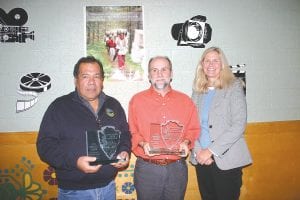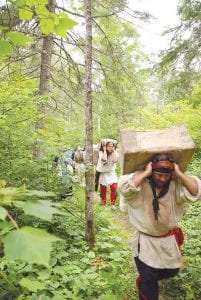There was a red carpet, theater style refreshments and an award presentation, making the premiere of Rendezvous with History: A Grand Portage Story a historic event in its own right. Over 300 people turned out for this gala evening and by early reviews, the interpretive film is a huge hit.
The film was created by the Grand Portage National Monument for use at the Grand Portage Heritage Center, but as National Monument Chief of Interpretation Pam Neil said, “They say it takes a village to raise a child. Well, it took a village to make this film.”
Neil and Karl Koster shared emcee duties at the film premiere and they expressed thanks to all who had been involved with making the film. Neil said they did not want to even attempt to list everyone, as they would certainly leave someone out. However, they stressed that the film could not have been made without the cooperation from the Grand Portage community.

Below: Before the film, there were brief speeches and acknowledgements of the many people who helped make the film a reality. National Park Service Midwest Region Deputy Director Patricia Trap (right) presented partnership awards to Grand Portage Tribal Chair Norman Deschampe and Grand Portage National Monument Superintendent Dr. Timothy Cochrane.
That thought was echoed by the other speakers—Dr. Timothy Cochrane, Grand Portage National Monument superintendent, and Norman Deschampe, Grand Portage tribal chair. Both men spoke of the history of cooperation between the Grand Portage Band of Lake Superior Chippewa and the National Park Service.
That partnership was highlighted with a presentation by National Park Service Midwest Region Deputy Director Patricia Trap. Trap called Tribal Chair Deschampe and Superintendent Cochrane forward to receive elegant crystal awards recognizing the efforts the two men have put into preserving the history of the Grand Portage community.
The producer/director of the film, Chris Wheeler of Great Divide Pictures, spoke last and he, too, thanked the community for its cooperation and participation in the creation of the film. However, he added a special thanks to Grand Portage photographer Travis Novitsky. “He’s a Minnesota treasure,” said Wheeler. “His photos inspired us as filmmakers.”
Wheeler also added an extra thanks to Karl Koster, who, he said, was an expert on all things voyageur. “No matter what we asked of him, he never said no,” said Wheeler.
The only problem he encountered in making the film, said Wheeler, was the absence of a beaver. He noted that a film about the fur trade could not be made without a beaver, but in all the weeks of shooting, a beaver was not to be found. Every time he got a call reporting a beaver in the vicinity, it was gone when he arrived.
Until the very last day of shooting, when Wheeler was packing to leave Grand Portage. A final call and at last, the animal was still there when he arrived. “So, the beaver that appears in this film is a real, live, and finally cooperative Grand Portage beaver!” said Wheeler.
With that, the lights were dimmed and the movie began. Not with a soaring Hollywood movie score, but with the gentle sound of a loon and water lapping on Lake Superior’s shore. The historical story is told through the words of a young Anishinabe man and finishes with a moving connection to today—a slide show of familiar faces—Grand Portage Band members, young and old.
The audience was very quiet throughout the 20-minute film, but as the final scene faded and the gentle call of the loon was heard again, the room erupted into applause. During a brief intermission, audience members came forward to talk to the producer, the actors (many of them Grand Portage community members), and National Park staff, congratulating them on a job well done.
After the intermission, the film was shown again, this time narrated not by First Nations actor Adam Beach, but by Gordan Jourdain or Maajiigwaneyaash, in Ojibwe. The film was just as stunning the second time around—the Grand Portage story very well told.



Loading Comments